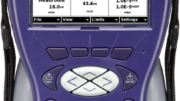If you get bored, take a look at pretty much anything with a plug in your home. It seems like there are a million little badges on your average piece of computer hardware, and almost as many in something as boring as a blender. What’s more the badge-a-palooza has migrated to otherwise simple devices like light bulbs.
The only exception is your cell phone. Due to some sketchy legislation from about a decade ago, cell phone makers aren’t required to put compliance badges on the back of phones. Any device which can store that data in read-only memory can be exempt from that regulation, technically. It’s just phone makers who take advantage of it.
Each one of the symbols you do see has some sort of legal reason for being there. They symbolize that the thing was reviewed by the FCC or EC (or both.) They tell you how you can or can’t dispose of it. And then there’s sometimes this weird little logo that looks like what you see at the top of this article. It’s called RoHS and it’s on a lot of stuff.
Here’s what I found out
RoHS compliance seems to show up on an increasing number of devices lately. I did a little digging and discovered a lot to like about RoHS.
It’s actually a European directive aimed toward the “Restriction of Hazardous Substances.” The idea is that the product has only trace amounts (or no amount at all) of these poisonous substances:
- Lead (Pb)
- Mercury (Hg)
- Cadmium (Cd)
- Hexavalent chromium (Cr6+)
- Polybrominated biphenyls (PBB)
- Polybrominated diphenyl ether (PBDE)
- Bis(2-ethylhexyl) phthalate (DEHP)
- Butyl benzyl phthalate (BBP)
While all of these are chemicals or elements found in nature, they are all poisonous to plants and animals in anything but tiny amounts. They’re also commonly found in things like light bulbs, batteries, circuit boards, and are used in the manufacture of the plastic and metal conveniences we take for granted.
RoHS went into effect in 2006 and it turns out it’s a pretty tough standard to meet. If one component fails, the entire part fails, and if the part fails, the whole thing fails. Put it this way. If one capacitor in the radio isn’t RoHS compliant, the whole car isn’t RoHS compliant. It’s that tough.
RoHS compliance is a big thing because almost everything in our modern world wears out or becomes obsolete in a fairly short period of time. Lead or cadmium can poison a stream for decades, due to batteries that only lasted a month. No matter who you are or where you fall on the political spectrum, that seems like a bad deal, right? Manufacturing processes that avoid the use of harmful chemicals just seem like the better way to go.
One more thing about RoHS
Most devices for sale in most parts of the US don’t require RoHS compliance. In most states in the US it’s not even a thing. However, California has laws limiting some of the same things that RoHS limits. Anything that you can’t sell in California is at a bit of a disadvantage in the other 49 states. So, manufacturers do tend to follow those standards in the US as well.





